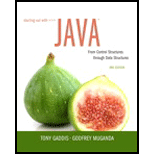
Starting Out with Java: From Control Structures through Data Structures (3rd Edition)
3rd Edition
ISBN: 9780134038179
Author: Tony Gaddis, Godfrey Muganda
Publisher: PEARSON
expand_more
expand_more
format_list_bulleted
Textbook Question
Chapter 20, Problem 6SA
Consult the online Java documentation and determine the differences between the StringBuffer and StringBuilder classes.
Expert Solution & Answer
Want to see the full answer?
Check out a sample textbook solution
Students have asked these similar questions
using r languange
using r language
show all the work
Chapter 20 Solutions
Starting Out with Java: From Control Structures through Data Structures (3rd Edition)
Ch. 20.1 - Prob. 20.1CPCh. 20.1 - Prob. 20.2CPCh. 20.3 - Prob. 20.4CPCh. 20 - A list is a collection that _____. a. associates...Ch. 20 - Prob. 2MCCh. 20 - Prob. 3MCCh. 20 - Prob. 4MCCh. 20 - Prob. 5MCCh. 20 - Prob. 6MCCh. 20 - Prob. 7MC
Ch. 20 - Prob. 11TFCh. 20 - Prob. 12TFCh. 20 - Prob. 13TFCh. 20 - Prob. 14TFCh. 20 - Prob. 15TFCh. 20 - Prob. 16TFCh. 20 - Prob. 17TFCh. 20 - Prob. 18TFCh. 20 - Prob. 29TFCh. 20 - Prob. 20TFCh. 20 - Prob. 1FTECh. 20 - Prob. 2FTECh. 20 - Prob. 3FTECh. 20 - Prob. 4FTECh. 20 - Prob. 5FTECh. 20 - Prob. 1AWCh. 20 - Prob. 2AWCh. 20 - Prob. 3AWCh. 20 - Prob. 4AWCh. 20 - Prob. 3SACh. 20 - Prob. 4SACh. 20 - Prob. 5SACh. 20 - Consult the online Java documentation and...Ch. 20 - Prob. 1PCCh. 20 - Prob. 2PC
Additional Engineering Textbook Solutions
Find more solutions based on key concepts
What is a data sublanguage?
Database Concepts (8th Edition)
Determine the reactions at the supports A and B, then draw the shear and moment diagram. El is constant. Neglec...
Mechanics of Materials (10th Edition)
In Exercises 41 through 46, identify the errors.
Introduction To Programming Using Visual Basic (11th Edition)
In the text, JUMP instructions were expressed by identifying the destination explicitly by stating the name (or...
Computer Science: An Overview (13th Edition) (What's New in Computer Science)
Consider the following skeletal C program: void fun1(void); / prototype / void fun2(void); / prototype / void f...
Concepts Of Programming Languages
State whether each of the following is true or false. A set of statements contained within a pair of parenthese...
Java How to Program, Early Objects (11th Edition) (Deitel: How to Program)
Knowledge Booster
Learn more about
Need a deep-dive on the concept behind this application? Look no further. Learn more about this topic, computer-science and related others by exploring similar questions and additional content below.Similar questions
- show all the workarrow_forwardList down the strenghts and weaknesses of your team project for Capsim Simulation? Explan.arrow_forwardCapsim Team PowerPoint Presentations - Slide Title: Key LearningsWhat were the key learnings that you discovered as a team through your Capsim simulation?arrow_forward
- Write the SQL code that permits to implement the tables: Student and Transcript. NB: Add the constraints on the attributes – keys and other.arrow_forwardDraw an ERD that will involve the entity types: Professor, Student, Department and Course. Be sure to add relationship types, key attributes, attributes and multiplicity on the ERD.arrow_forwardDraw an ERD that represents a book in a library system. Be sure to add relationship types, key attributes, attributes and multiplicity on the ERD.arrow_forward
- 2:21 m Ο 21% AlmaNet WE ARE HIRING Experienced Freshers Salesforce Platform Developer APPLY NOW SEND YOUR CV: Email: hr.almanet@gmail.com Contact: +91 6264643660 Visit: www.almanet.in Locations: India, USA, UK, Vietnam (Remote & Hybrid Options Available)arrow_forwardProvide a detailed explanation of the architecture on the diagramarrow_forwardhello please explain the architecture in the diagram below. thanks youarrow_forward
arrow_back_ios
SEE MORE QUESTIONS
arrow_forward_ios
Recommended textbooks for you
 EBK JAVA PROGRAMMINGComputer ScienceISBN:9781337671385Author:FARRELLPublisher:CENGAGE LEARNING - CONSIGNMENT
EBK JAVA PROGRAMMINGComputer ScienceISBN:9781337671385Author:FARRELLPublisher:CENGAGE LEARNING - CONSIGNMENT EBK JAVA PROGRAMMINGComputer ScienceISBN:9781305480537Author:FARRELLPublisher:CENGAGE LEARNING - CONSIGNMENT
EBK JAVA PROGRAMMINGComputer ScienceISBN:9781305480537Author:FARRELLPublisher:CENGAGE LEARNING - CONSIGNMENT- Np Ms Office 365/Excel 2016 I NtermedComputer ScienceISBN:9781337508841Author:CareyPublisher:Cengage
 Principles of Information Systems (MindTap Course...Computer ScienceISBN:9781285867168Author:Ralph Stair, George ReynoldsPublisher:Cengage Learning
Principles of Information Systems (MindTap Course...Computer ScienceISBN:9781285867168Author:Ralph Stair, George ReynoldsPublisher:Cengage Learning Systems ArchitectureComputer ScienceISBN:9781305080195Author:Stephen D. BurdPublisher:Cengage Learning
Systems ArchitectureComputer ScienceISBN:9781305080195Author:Stephen D. BurdPublisher:Cengage Learning

EBK JAVA PROGRAMMING
Computer Science
ISBN:9781337671385
Author:FARRELL
Publisher:CENGAGE LEARNING - CONSIGNMENT


EBK JAVA PROGRAMMING
Computer Science
ISBN:9781305480537
Author:FARRELL
Publisher:CENGAGE LEARNING - CONSIGNMENT

Np Ms Office 365/Excel 2016 I Ntermed
Computer Science
ISBN:9781337508841
Author:Carey
Publisher:Cengage

Principles of Information Systems (MindTap Course...
Computer Science
ISBN:9781285867168
Author:Ralph Stair, George Reynolds
Publisher:Cengage Learning

Systems Architecture
Computer Science
ISBN:9781305080195
Author:Stephen D. Burd
Publisher:Cengage Learning
Files & File Systems: Crash Course Computer Science #20; Author: CrashCourse;https://www.youtube.com/watch?v=KN8YgJnShPM;License: Standard YouTube License, CC-BY
UNIX Programming (Part - 10) The File System (Directories and Files Names); Author: ITUTEES;https://www.youtube.com/watch?v=K35faWBhzrw;License: Standard Youtube License